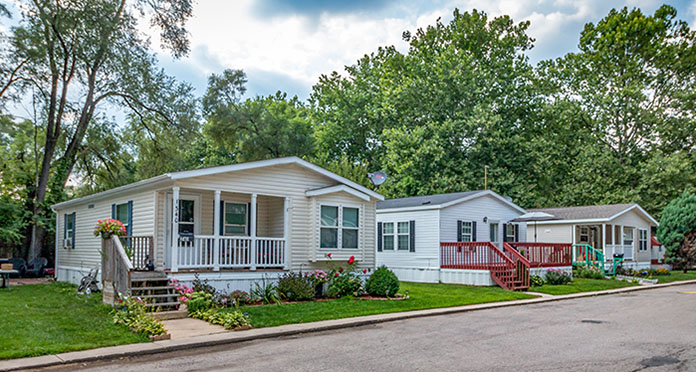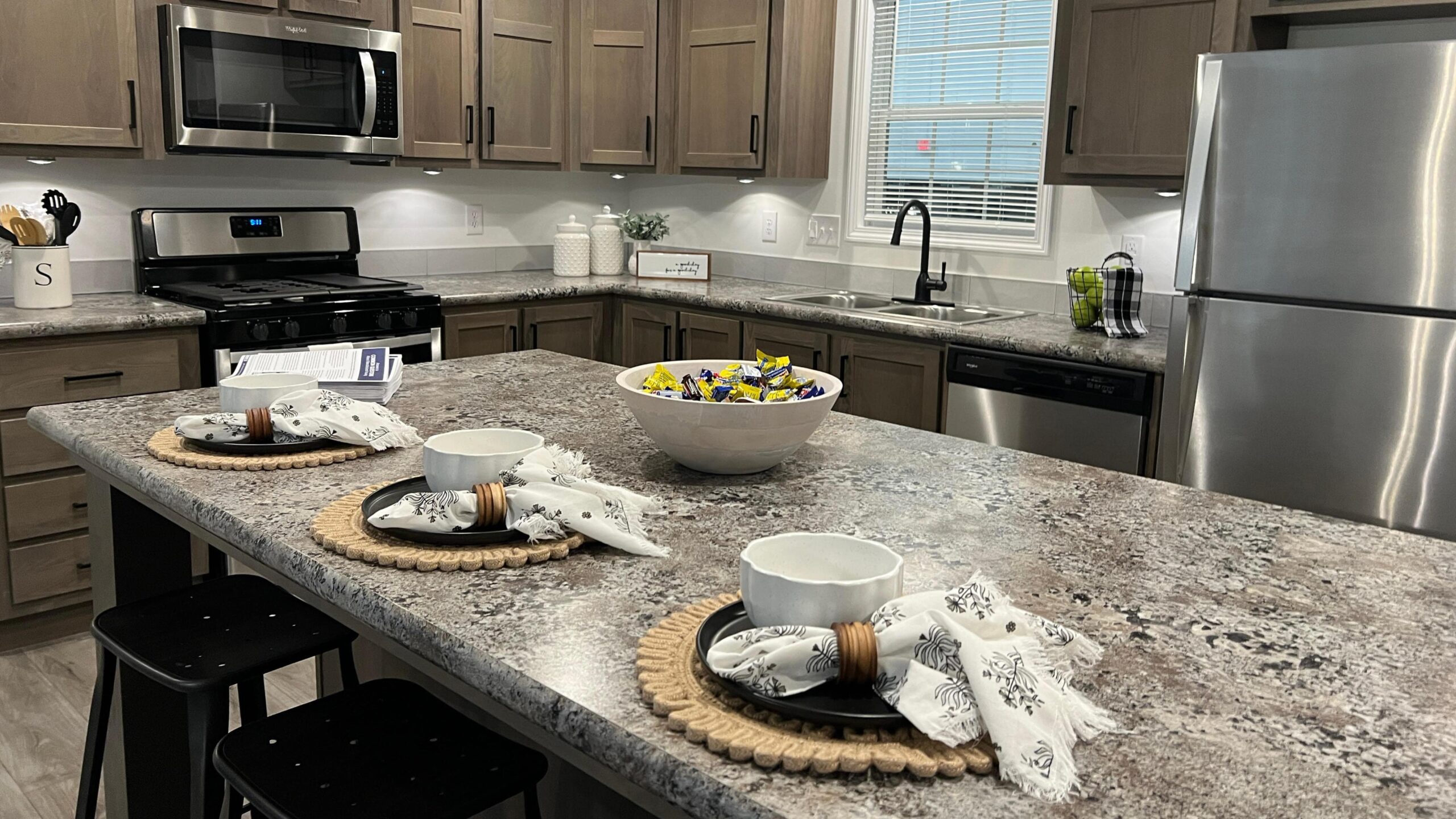Mobile home skirting (also called mobile home underpinning) is a barrier made from hard material that protects the underside of your manufactured home and keeps it safe from all kinds of threats. While it’s an often forgotten component of mobile home maintenance, your home almost certainly needs it.
Mobile home skirting is required around a manufactured home’s bottom exterior to keep away pests and moisture. Additionally, the installation of skirting can enhance the visual appeal of the home by masking piers, tie-downs and the concrete slab.
Many online marketplaces and corner hardware stores sell mobile home skirting. However, the question remains…what look is best for you? What features should you look for in mobile home skirting, and what material is best to use?
The Key Benefits of Skirting for Mobile Homes
Many manufactured homes use a pier and beam foundation, which means the homes sit a few feet off the ground. To cover the gap between the home and the ground, homeowners use skirting for a smooth, seamless finish across the entire home.
Skirting fulfills important functions such as:
- Helping your home maintain a more consistent temperature and keeping moisture away
- Preventing animals from nesting under your home
- Protecting your home’s foundation and plumbing from weather conditions
- Enhancing the visual appeal of your home by providing a finished and stately look for your home
In addition, federal Housing and Urban Development code requires skirting on any manufactured home.
Standard vinyl skirting comes in 12-foot long panels. It’s cut to width for the average height off the ground from the bottom of the home. Vinyl is the least expensive option (more on that below), and comes in solid panels or panels with ventilation holes.
Types of Mobile Home Skirting
Many types of mobile home skirting are available, but the most common are:
- Vinyl Mobile Home Skirting: The most popular choice, thanks to its cost-effective nature and ease of installation. Vinyl mobile home skirting is a solid choice, but note that it can be vulnerable to moisture and needs to be vented well (see below).
- Brick and Cinderblock Mobile Home Skirting: These are great options for a homeowner who plans to stay put. Brick and cinderblock are pricey and labor-intensive to install, but they provide great insulation and are extremely durable.
- Wood Mobile Home Skirting: Wood skirting looks great on a manufactured home, particularly if paired with wood paneling. But it retains a lot of moisture, meaning that ventilation is especially critical. Varieties with water-resistant features like pressure-treated wood or cedar should be strongly considered.
- Metal Mobile Home Skirting: Metal skirting made from steel, tin or aluminum is a perennially popular option. It’s durable, lightweight and relatively affordable. Like metal siding, its only real disadvantage is that it can be dented easily and that some types are vulnerable to rust.
- Faux Stone Skirting: Faux stone skirting is a stylized choice of skirting material for mobile home owners, given its low maintenance and durability. Since faux stone skirting is typically made of plastic, but made to look like stone, some types may be more durable than others.
- Cement Board Skirting: A highly durable option, cement board skirting – sometimes known as “hardie” skirting – comes in sheets, or blocks, and is one of the pricier options you’ll come across. Like with vinyl skirting, you’ll want to monitor for moisture over time to ensure the material doesn’t warp or crack.
Each type of skirting has different components. Vinyl skirting, for example, requires top and bottom tracks, a front piece, and screws to hold it in place. Buying your skirting from a reputable mobile home parts supplier will help ensure that you get all of the parts you need.
What You Will Need to Install Mobile Home Skirting
If you’re the do-it-yourself type and are interested in tackling the mobile home skirting installation on your own, here are a few tips to help you with the project:
Make sure you have the necessary equipment. The following tools will be required to install your own skirting:
- Drill and bit
- Hammer
- Tape measure
- Wood stakes
- Tin snips
- Spikes
- Nails
- Level
- Utility Knife
If you’re a homeowner with some handyman skills, replacing skirting on a single-section home could take you most of the weekend. On the other hand, it’s worth knowing that an experienced installer can finish most skirting-related jobs in about a day. You can typically expect to pay around $45/hour if you prefer hiring a professional for the project.
How Much Mobile Home Skirting Does My Home Need?
For a basic calculation of your mobile home’s skirting requirements, you’ll first need the total linear footage of your manufactured home. To find this, measure the length of all side of your home and porch, and add them together. You’ll also need the average distance of your home from the ground. To find this, go to each corner of your home and measure the distance from the ground to a point two inches above the bottom of the home. Add the numbers up and divide by the number of corners to find the average distance.
For more details, look at any of the instructions for measuring mobile home skirting available online. Pro tip: Purchase all of your skirting from the same source and at the same time so that you don’t get mixed lots that can result in mismatched colors and bad fits.
How Should I Vent My Mobile Home Skirting?
Venting is an important part of mobile home skirting installation because it prevents moisture from building up behind the skirting. Any new skirting should have vents installed in it, with a recommended ratio of 1 square foot of vent space per 150 square feet of manufactured home flooring. Make sure to place some vents close to the corners of your home to improve air circulation, and use screens on your vents to allow air to pass through without letting animals in. Unwanted moisture under the home will create mildew and possibly buckle the home’s floor joists, which is particularly common in wet states like Louisiana and Michigan.
A ground vapor barrier is another good way to control moisture under your manufactured home. GVBs are plastic barriers placed directly on the ground to prevent moisture from seeping up into the foundations of your home. They can greatly reduce the amount of moisture that needs to be vented out through your skirting.
Faux and textured panels are solid and trap ground moisture below the home. The recommendation is to only use the solid panels on three sides of the home and to use a ventilated material on the rear of the home. This approach provides some ventilation, but is less effective than having a home ventilated on all sides.
Should My Mobile Home Skirting Be Insulated?
Some manufactured home experts maintain that skirting should always be insulated, while some say separate insulation isn’t necessary. If you live in a colder climate, it may be worth investigating foam-insulated skirting, which comes pre-made with foam insulation backing. Again, experts disagree on whether it’s cost-effective, but it can be a potential difference-maker for some manufactured home owners.
Learn more key information about mobile home remodels and upgrades that make a manufactured home safe and enjoyable.
Mobile Home Skirting Maintenance
Skirting of nearly any variety can sustain damage or be destroyed by a weeder, among other lawn equipment. This will be unsightly and provide access for water to enter. Additionally, these compromises in the mobile home skirting provide an animal gateway to chew on wiring and harm other utilities. Worse yet, they could take up residence under your mobile home.
There are two primary approaches to beating back skirting damage caused by weeding. First, consider putting down a few inches of plastic and landscaping stone around the skirting. Second, you can spray chemical weed killer, which tends to yellow the surrounding foliage. But, as a result, the remaining spray could be toxic for pets and children.
Want more tips for improving your home exterior? Check out our guides for mobile home siding, mobile home porches, and mobile home steps.














